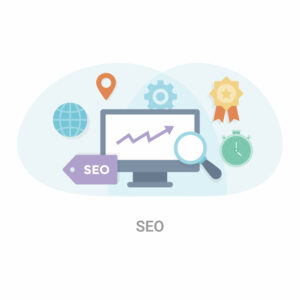Your website is often the first point of contact for potential customers. If it’s poorly designed, it can create a negative impression, drive visitors away, and cost your business revenue. Let’s take a look at how a bad website affects your business and why investing in professional web design is necessary for long-term success.
At Texas Web Design, we create impactful, user-friendly websites tailored to drive growth and enhance your business. Contact us now to start building a website that boosts your revenue and grows your business.
Loss of Trust and Credibility
Your website’s design speaks volumes about your business. If it looks outdated, is difficult to navigate, or fails to load quickly, visitors may doubt your professionalism. Research shows that 75% of users evaluate a company’s credibility by its website design. Without trust, potential customers are less likely to engage with your brand or make a purchase.
Industries that rely heavily on trust, such as healthcare, law, and finance, are especially vulnerable to the effects of a poorly designed website. A lack of confidence in your online presence can push customers toward competitors with better websites.
Higher Bounce Rates Hurt Growth
When a website has slow loading times, cluttered layouts, or confusing navigation, visitors leave quickly. This behavior, known as bouncing, indicates to search engines that your site doesn’t meet user needs. Ensuring a seamless user experience with effective navigation and responsive design can help retain visitors and minimize bounce rates. As a result, your search rankings drop, making it harder for people to find your business online.
This creates a cycle: visitors leave, search engines lower your visibility, and you lose more opportunities. The longer this continues, the harder it becomes to reverse the damage and recover your audience.
Missed Opportunities to Convert Visitors
A well-designed website, incorporating effective visual elements, guides visitors smoothly through the process of learning about your business and taking action. Poor design interrupts this flow.
For example:
- Fonts that are difficult to read or poor color choices can make content less accessible.
- Confusing menus frustrate visitors and make it hard to find key information.
- Missing or unclear call-to-action (CTA) buttons leave users unsure of their next step, whether it’s contacting you, signing up, or completing a purchase.
Even small obstacles, like a misplaced contact form or poorly written product descriptions, can discourage visitors from becoming customers, directly impacting your revenue.
Search Engine Optimization Performance Takes a Hit
 Search engines prioritize websites that offer a positive user experience. If your site is not mobile-friendly, loads slowly, or lacks clear organization, it will struggle to rank well in search engine results. This reduces your visibility and makes it harder for potential customers to find your business.
Search engines prioritize websites that offer a positive user experience. If your site is not mobile-friendly, loads slowly, or lacks clear organization, it will struggle to rank well in search engine results. This reduces your visibility and makes it harder for potential customers to find your business.
For example:
- Mobile Optimization: With over half of web traffic coming from mobile devices, websites that don’t adapt to different screen sizes miss out on a large portion of potential visitors.
- Slow Loading Times: Research shows that users abandon websites that take more than three seconds to load. This reduces engagement and signals poor performance to search engines.
Without visibility in search results, your website becomes much less effective as a marketing tool.
Falling Behind Competitors
If your competitors have better-designed websites that incorporate modern web design practices, they’re likely winning over your audience. An easy-to-use, visually appealing site will always outperform one that’s outdated or difficult to navigate. In highly competitive industries, this difference can determine whether a potential customer chooses your business or someone else’s.
By ignoring your website’s design, you risk losing your market share to competitors who prioritize their online presence.
Hidden Costs of Poor Design
While cutting corners on web design might seem like a cost-saving measure, it often leads to higher expenses over time due to various web design challenges. Fixing ongoing issues, updating outdated features, or undergoing a complete redesign later can cost far more than doing it right from the start.
Additionally, a poorly performing website forces businesses to spend more on paid advertising to compensate for low organic traffic and poor conversion rates. Instead of serving as a cost-effective tool, your website becomes a financial burden.
Brand Perception Suffers
Your website reflects your brand. If it looks unprofessional or outdated, visitors may question the quality of your products or services. On the other hand, a modern, clean website that prioritizes web accessibility conveys reliability and competence, helping to build trust with your audience.
For instance, high-end or luxury brands can lose credibility if their websites don’t reflect the same level of quality as their offerings. The same principle applies to any business—your website is part of your brand identity and should represent it positively.
Poor User Experience Repels Customers
A website that frustrates users creates a poor experience.
Some common issues include:
- Broken links that lead to error pages.
- Missing accessibility features, such as alt text for images or accessible labels for buttons, prevent users relying on screen readers from engaging with your content.
- Unorganized navigation makes it difficult to locate information.
A good user experience is one that makes it easy for visitors to find what they need and complete their intended actions. When visitors have a positive experience, they’re more likely to stay, engage, and convert into paying customers.
Is Your Website Holding You Back?
How do you know if your website needs improvement?
Here are common signs:
- Outdated design that doesn’t look appealing.
- Slow page loading times frustrate visitors.
- Lack of mobile responsiveness makes the site difficult to use on smartphones or tablets, which can alienate mobile users.
- A confusing layout or structure that makes it hard for users to find key information.
- High bounce rates, where visitors leave shortly after arriving.
If your website shows any of these issues, it’s time to consider updating or redesigning it.
What Makes a Website Effective?
A successful website should prioritize the following:
- Easy navigation: Visitors should be able to find what they need without confusion.
- Responsive web design: The site should function well on any device, from desktops to smartphones. Responsive web design ensures that websites look good and perform well across all devices, using techniques like fluid grids and CSS media queries to adapt layouts according to screen sizes.
- Fast loading times: A slow website drives users away and hurts search rankings.
- Clear CTAs: Help visitors understand their next step, whether it’s contacting you, signing up, or purchasing.
- Modern visuals: A professional, polished design builds trust and encourages visitors to stay longer.
Turn Your Website Into an Asset
A bad website isn’t just an inconvenience—it’s a liability that can hurt your business, damage your reputation, and drain your resources. On the other hand, a well-designed website serves as a powerful tool to engage your audience, increase visibility, and drive conversions.
At Texas Web Design, we create websites that combine functionality with attractive design to help your business succeed. Whether you need a complete overhaul or minor improvements, our team is here to transform your website into a valuable asset.
Don’t let your website hold you back. Contact Texas Web Design today and discover how a great website can drive your success!

